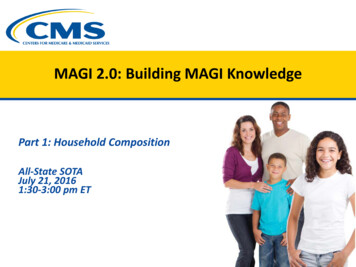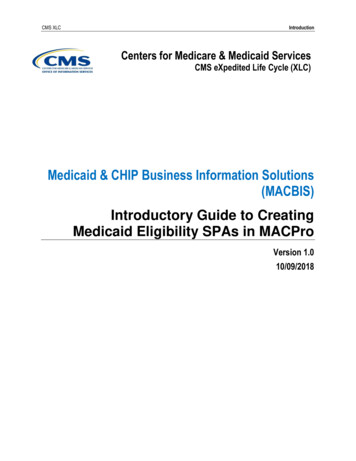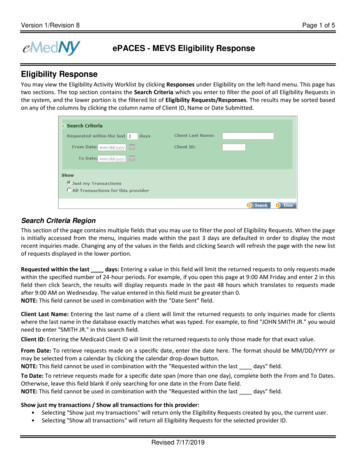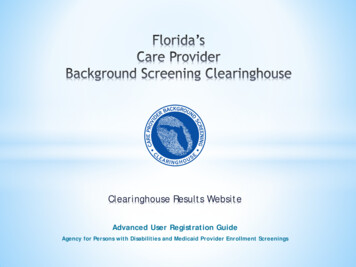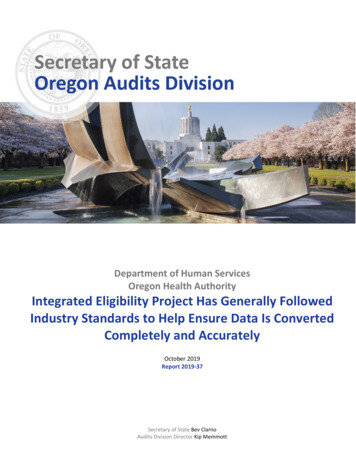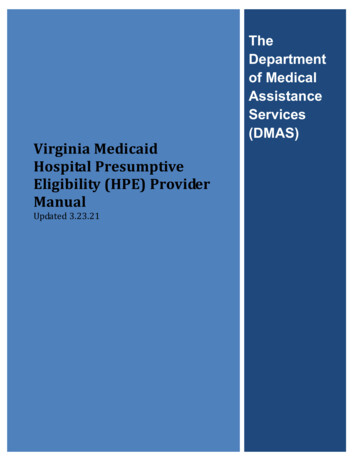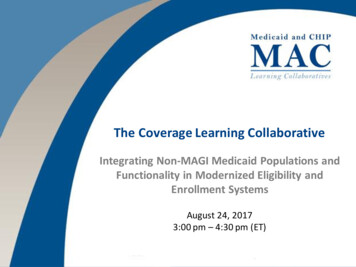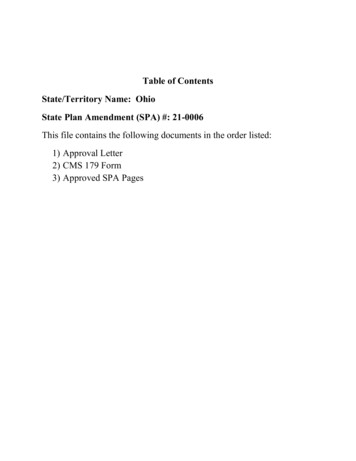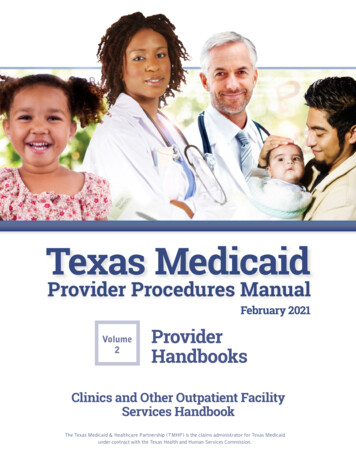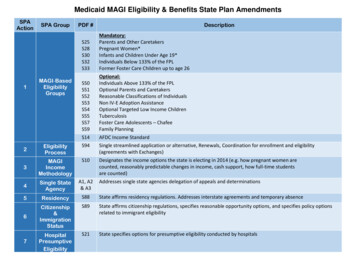
Transcription
Medicaid MAGI Eligibility & Benefits State Plan AmendmentsSPAAction1SPA GroupMAGI‐BasedEligibilityGroupsPDF #DescriptionS25S28S30S32S33Mandatory:Parents and Other CaretakersPregnant Women*Infants and Children Under Age 19*Individuals Below 133% of the FPLFormer Foster Care Children up to age 26S50S51S52S53S54S55S57S59Optional:Individuals Above 133% of the FPLOptional Parents and CaretakersReasonable Classifications of IndividualsNon IV‐E Adoption AssistanceOptional Targeted Low Income ChildrenTuberculosisFoster Care Adolescents – ChafeeFamily PlanningS14AFDC Income Standard2EligibilityProcessS94Single streamlined application or alternative, Renewals, Coordination for enrollment and eligibility(agreements with Exchanges)S103MAGIIncomeMethodologyDesignates the income options the state is electing in 2014 (e.g. how pregnant women arecounted, reasonably predictable changes in income, cash support, how full‐time studentsare counted)4Single StateAgencyA1, A2& A35ResidencyS88State affirms residency regulations. Addresses interstate agreements and temporary absenceS896Citizenship&ImmigrationStatusState affirms citizenship regulations, specifies reasonable opportunity options, and specifies policy optionsrelated to immigrant eligibilityS21State specifies options for presumptive eligibility conducted by hospitals7HospitalPresumptiveEligibilityAddresses single state agencies delegation of appeals and determinations
Medicaid EligibilityOMB Control Number: 0938‐1148State Name: DelawareTransmittal Number: 13 - 00- 05Eligibility Groups - Mandatory CoverageParents and Other Caretaker RelativesS2542 CFR 435.1101902(a)(10)(A)(i)(I)1931(b) and (d) Parents and Other Caretaker Relatives - Parents and other caretaker relatives of dependent children with household income at orbelow a standard established by the state. The state attests that it operates this eligibility group in accordance with the following provisions: Individuals qualifying under this eligibility group must meet the following criteria: Are parents or other caretaker relatives (defined at 42 CFR 435.4), including pregnant women, of dependent children(defined at 42 CFR 435.4) under age 18. Spouses of parents and other caretaker relatives are also included.The state elects the following options:This eligibility group includes individuals who are parents or other caretakers of children who are 18 years old,provided the children are full-time students in a secondary school or the equivalent level of vocational ortechnical training.Options relating to the definition of caretaker relative (select any that apply):The definition of caretaker relative includes the domestic partner of the parent or other caretaker relative,even after the partnership is terminated.Definition of domesticpartner:Unmarried partner whether of the same or different genderThe definition of caretaker relative includes other relatives of the child based on blood (including those ofhalf-blood), adoption or marriage.Description of otherrelatives:The definition of caretaker relative includes any adult with whom the child is living and who assumesprimary responsibility for the dependent child's care.Options relating to the definition of dependent child (select the one that applies):The state elects to eliminate the requirement that a dependent child must be deprived of parental support orcare by reason of the death, physical or mental incapacity, or absence from the home or unemployment of atleast one parent.TN No. 13-0005 MMApproval Date: 12/6/2013Effective Date: 01/01/2014Page 1 of 3
Medicaid EligibilityThe child must be deprived of parental support or care, but a less restrictive standard is used to measureunemployment of the parent (select the one that applies): Have household income at or below the standard established by the state. MAGI-based income methodologies are used in calculating household income. Please refer as necessary to S10 MAGIBased Income Methodologies, completed by the state. Income standard used for this group Minimum income standardThe minimum income standard used for this group is the state's AFDC payment standard in effect as of May 1, 1988,converted to MAGI-equivalent amounts by household size. The standard is described in S14 AFDC Income Standards. The state certifies that it has submitted and received approval for its converted May 1, 1988 AFDC paymentstandard.An attachment is submitted. Maximum income standard The state certifies that it has submitted and received approval for its converted income standard(s) for parents andother caretaker relatives to MAGI-equivalent standards and the determination of the maximum income standard tobe used for parents and other caretaker relatives under this eligibility group.An attachment is submitted.The state's maximum income standard for this eligibility group is:The state's effective income level for section 1931 families under the Medicaid state plan as of March 23, 2010,converted to a MAGI-equivalent percent of FPL or amounts by household size.The state's effective income level for section 1931 families under the Medicaid state plan as of December 31,2013, converted to a MAGI-equivalent percent of FPL or amounts by household size.The state's effective income level for any population of parents/caretaker relatives under a Medicaid 1115demonstration as of March 23, 2010, converted to a MAGI-equivalent percent of FPL or amounts by householdsize.The state's effective income level for any population of parents/caretaker relatives under a Medicaid 1115demonstration as of December 31, 2013, converted to a MAGI-equivalent percent of FPL or amounts byhousehold size.Enter the amount of the maximum income standard:TN No. 13-0005 MMApproval Date: 12/6/2013Effective Date: 01/01/2014Page 2 of 3
Medicaid EligibilityA percentage of the federal poverty level: 87%The state's AFDC payment standard in effect as of July 16, 1996, converted to a MAGI-equivalent standard. Thestandard is described in S14 AFDC Income Standards.The state's AFDC payment standard in effect as of July 16, 1996, increased by no more than the percentageincrease in the Consumer Price Index for urban consumers (CPI-U) since such date, converted to a MAGIequivalent standard. The standard is described in S14 AFDC Income Standards.The state's TANF payment standard, converted to a MAGI-equivalent standard. The standard is described in S14AFDC Income Standards.Other dollar amount Income standard chosen:Indicate the state's income standard used for this eligibility group:The minimum income standardThe maximum income standardThe state's AFDC payment standard in effect as of July 16, 1996, increased by no more than the percentageincrease in the Consumer Price Index for urban consumers (CPI-U) since such date. The standard is described inS14 AFDC Income Standards.Another income standard in-between the minimum and maximum standards allowed There is no resource test for this eligibility group. Presumptive EligibilityThe state covers individuals under this group when determined presumptively eligible by a qualified entity. The state assuresit also covers individuals under the Pregnant Women (42 CFR 435.116) and/or Infants and Children under Age 19 (42 CFR435.118) eligibility groups when determined presumptively eligible.YesNoPRA Disclosure StatementAccording to the Paperwork Reduction Act of 1995, no persons are required to respond to a collection of information unless it displays avalid OMB control number. The valid OMB control number for this information collection is 0938‐1148. The time required to completethis information collection is estimated to average 40 hours per response, including the time to review instructions, search existing dataresources, gather the data needed, and complete and review the information collection. If you have comments concerning the accuracy ofthe time estimate(s) or suggestions for improving this form, please write to: CMS, 7500 Security Boulevard, Attn: PRA Reports ClearanceOfficer, Mail Stop C4‐26‐05, Baltimore, Maryland 21244‐1850.V.20160722TN No. 13-0005 MMApproval Date: 12/6/2013Effective Date: 01/01/2014Page 3 of 3
Medicaid EligibilityOMB Control Number: 0938‐1148State Name: DelawareTransmittal Number: 13 - 00 - 0005Eligibility Groups - Mandatory CoveragePregnant WomenS2842 CFR 435.1161902(a)(10)(A)(i)(III) and (IV)1902(a)(10)(A)(ii)(I), (IV) and (IX)1931(b) and (d)1920 Pregnant Women - Women who are pregnant or post-partum, with household income at or below a standard established by the state. The state attests that it operates this eligibility group in accordance with the following provisions: Individuals qualifying under this eligibility group must be pregnant or post-partum, as defined in 42 CFR 435.4.Pregnant women in the last trimester of their pregnancy without dependent children are eligible for full benefits under thisgroup in accordance with section 1931 of the Act, if they meet the income standard for state plan Parents and OtherCaretaker Relatives at 42 CFR 435.110.YesNo MAGI-based income methodologies are used in calculating household income. Please refer as necessary to S10 MAGI-BasedIncome Methodologies, completed by the state. Income standard used for this group Minimum income standard (Once entered and approved by CMS, the minimum income standard cannot be changed.)The state had an income standard higher than 133% FPL established as of December 19, 1989 for determiningeligibility for pregnant women, or as of July 1, 1989, had authorizing legislation to do so.YesNoThe minimum income standard for this eligibility group is 133% FPL. Maximum income standard The state certifies that it has submitted and received approval for its converted income standard(s) for pregnantwomen to MAGI-equivalent standards and the determination of the maximum income standard to be used forpregnant women under this eligibility group.An attachment is submitted.The state's maximum income standard for this eligibility group is:The state's highest effective income level for coverage of pregnant women under sections 1931 (low-incomefamilies), 1902(a)(10)(A)(i)(III) (qualified pregnant women), 1902(a)(10)(A)(i)(IV) (mandatory poverty levelrelated pregnant women), 1902(a)(10)(A)(ii)(IX) (optional poverty level-related pregnant women), 1902(a)(10)(A)(ii)(I) (pregnant women who meet AFDC financial eligibility criteria) and 1902(a)(10)(A)(ii)(IV)(institutionalized pregnant women) in effect under the Medicaid state plan as of March 23, 2010, converted to aMAGI-equivalent percent of FPL.TN No 13-0005 MMApproval Date: 12/06/2013Effective Date: 01/01/2014Page 1 of 2
Medicaid EligibilityThe state's highest effective income level for coverage of pregnant women under sections 1931 (low-incomefamilies), 1902(a)(10)(A)(i)(III) (qualified pregnant women), 1902(a)(10)(A)(i)(IV) (mandatory poverty levelrelated pregnant women), 1902(a)(10)(A)(ii)(IX) (optional poverty level-related pregnant women), 1902(a)(10)(A)(ii)(I) (pregnant women who meet AFDC financial eligibility criteria) and 1902(a)(10)(A)(ii)(IV)(institutionalized pregnant women) in effect under the Medicaid state plan as of December 31, 2013, converted toa MAGI-equivalent percent of FPL.The state's effective income level for any population of pregnant women under a Medicaid 1115 demonstration asof March 23, 2010, converted to a MAGI-equivalent percent of FPL.The state's effective income level for any population of pregnant women under a Medicaid 1115 demonstration asof December 31, 2013, converted to a MAGI-equivalent percent of FPL.185% FPLThe amount of the maximum income standard is: 212 % FPLIncome standard chosenIndicate the state's income standard used for this eligibility group:The minimum income standardThe maximum income standardAnother income standard in-between the minimum and maximum standards allowed. There is no resource test for this eligibility group. Benefits for individuals in this eligibility group consist of the following:All pregnant women eligible under this group receive full Medicaid coverage under this state plan.Pregnant women whose income exceeds the income limit specified below for full coverage of pregnant women receiveonly pregnancy-related services. Presumptive EligibilityThe state covers ambulatory prenatal care for individuals under this group when determined presumptively eligible by aqualified entity.YesNoPRA Disclosure StatementAccording to the Paperwork Reduction Act of 1995, no persons are required to respond to a collection of information unless it displays avalid OMB control number. The valid OMB control number for this information collection is 0938‐1148. The time required to completethis information collection is estimated to average 40 hours per response, including the time to review instructions, search existing dataresources, gather the data needed, and complete and review the information collection. If you have comments concerning the accuracy ofthe time estimate(s) or suggestions for improving this form, please write to: CMS, 7500 Security Boulevard, Attn: PRA Reports ClearanceOfficer, Mail Stop C4‐26‐05, Baltimore, Maryland 21244‐1850.V.20160722TN No 13-0005 MMApproval Date: 12/06/2013Effective Date: 01/01/2014Page 2 of 2
Medicaid EligibilityOMB Control Number: 0938‐1148State Name: DelawareTransmittal Number: 13 -- 0005Eligibility Groups - Mandatory CoverageInfants and Children under Age 19S3042 CFR 435.1181902(a)(10)(A)(i)(III), (IV), (VI) and (VII)1902(a)(10)(A)(ii)(IV) and (IX)1931(b) and (d) Infants and Children under Age 19 - Infants and children under age 19 with household income at or below standards established bythe state based on age group. The state attests that it operates this eligibility group in accordance with the following provisions: Children qualifying under this eligibility group must meet the following criteria: Are under age 19 Have household income at or below the standard established by the state. MAGI-based income methodologies are used in calculating household income. Please refer as necessary to S10 MAGIBased Income Methodologies, completed by the state. Income standard used for infants under age one Minimum income standardThe state had an income standard higher than 133% FPL established as of December 19, 1989 for determiningeligibility for infants under age one, or as of July 1, 1989, had authorizing legislation to do so.YesNoThe minimum income standard for infants under age one is 133% FPL. Maximum income standard The state certifies that it has submitted and received approval for its converted income standard(s) for infantsunder age one to MAGI-equivalent standards and the determination of the maximum income standard to be usedfor infants under age one.An attachment is submitted.The state's maximum income standard for this age group is:The state's highest effective income level for coverage of infants under age one under sections 1931 (low-incomefamilies), 1902(a)(10)(A)(i)(III) (qualified children), 1902(a)(10)(A)(i)(IV) (mandatory poverty level-relatedinfants), 1902(a)(10)(A)(ii)(IX) (optional poverty level-related infants) and 1902(a)(10)(A)(ii)(IV)(institutionalized children), in effect under the Medicaid state plan as of March 23, 2010, converted to a MAGIequivalent percent of FPL.TN No. 13-0005 MMApproval Date: 12/06/2013Effective Date: 01/01/2014Page 1 of 5
Medicaid EligibilityThe state's highest effective income level for coverage of infants under age one under sections 1931 (low-incomefamilies), 1902(a)(10)(A)(i)(III) (qualified children), 1902(a)(10)(A)(i)(IV) (mandatory poverty level-relatedinfants), 1902(a)(10)(A)(ii)(IX) (optional poverty level-related infants) and 1902(a)(10)(A)(ii)(IV)(institutionalized children), in effect under the Medicaid state plan as of December 31, 2013, converted to aMAGI-equivalent percent of FPL.The state's effective income level for any population of infants under age one under a Medicaid 1115demonstration as of March 23, 2010, converted to a MAGI-equivalent percent of FPL.The state's effective income level for any population of infants under age one under a Medicaid 1115demonstration as of December 31, 2013, converted to a MAGI-equivalent percent of FPL.185% FPLEnter the amount of the maximum income standard: 209 % FPLIncome standard chosenThe state's income standard used for infants under age one is:The maximum income standardIf not chosen as the maximum income standard, the state's highest effective income level for coverage of infantsunder age one under sections 1931 (low-income families), 1902(a)(10)(A)(i)(III) (qualified children), 1902(a)(10)(A)(i)(IV) (mandatory poverty level-related infants), 1902(a)(10)(A)(ii)(IX) (optional poverty level-relatedinfants) and 1902(a)(10)(A)(ii)(IV) (institutionalized children), in effect under the Medicaid state plan as ofMarch 23, 2010, converted to a MAGI-equivalent percent of FPL.If higher than the highest effective income level for this age group under the state plan as of March 23, 2010, andif not chosen as the maximum income standard, the state's highest effective income level for coverage of infantsunder age one under sections 1931 (low-income families), 1902(a)(10)(A)(i)(III) (qualified children), 1902(a)(10)(A)(i)(IV) (mandatory poverty level-related infants), 1902(a)(10)(A)(ii)(IX) (optional poverty level-relatedinfants) and 1902(a)(10)(A)(ii)(IV) (institutionalized children), in effect under the Medicaid state plan as ofDecember 31, 2013, converted to a MAGI-equivalent percent of FPL.If higher than the highest effective income level for this age group under the state plan as of March 23, 2010, andif not chosen as the maximum income standard, the state's effective income level for any population of infantsunder age one under a Medicaid 1115 demonstration as of March 23, 2010, converted to a MAGI-equivalentpercent of FPL.If higher than the highest effective income level for this age group under the state plan as of March 23, 2010, andif not chosen as the maximum income standard, the state's effective income level for any population of infantsunder age one under a Medicaid 1115 demonstration as of December 31, 2013, converted to a MAGI-equivalentpercent of FPL.Another income standard in-between the minimum and maximum standards allowed, provided it is higher thanthe effective income standard for this age group in the state plan as of March 23, 2010. Income standard for children age one through age five, inclusive Minimum income standardTN No. 13-0005 MMApproval Date: 12/06/2013Effective Date: 01/01/2014Page 2 of 5
Medicaid EligibilityThe minimum income standard used for this age group is 133% FPL. Maximum income standard The state certifies that it has submitted and received approval for its converted income standard(s) for childrenage one through five to MAGI-equivalent standards and the determination of the maximum income standard to beused for children age one through five.An attachment is submitted.The state's maximum income standard for children age one through five is:The state's highest effective income level for coverage of children age one through five under sections 1931 (lowincome families), 1902(a)(10)(A)(i)(III) (qualified children), 1902(a)(10)(A)(i)(VI) (mandatory poverty levelrelated children age one through five), and 1902(a)(10)(A)(ii)(IV) (institutionalized children), in effect under theMedicaid state plan as of March 23, 2010, converted to a MAGI-equivalent percent of FPL.The state's highest effective income level for coverage of children age one through five under sections 1931 (lowincome families), 1902(a)(10)(A)(i)(III) (qualified children), 1902(a)(10)(A)(i)(VI) (mandatory poverty levelrelated children age one through five), and 1902(a)(10)(A)(ii)(IV) (institutionalized children), in effect under theMedicaid state plan as of December 31, 2013, converted to a MAGI-equivalent percent of FPL.The state's effective income level for any population of children age one through five under a Medicaid 1115demonstration as of March 23, 2010, converted to a MAGI-equivalent percent of FPL.The state's effective income level for any population of children age one through five under a Medicaid 1115demonstration as of December 31, 2013, converted to a MAGI-equivalent percent of FPL.Enter the amount of the maximum income standard: 142 % FPLIncome standard chosenThe state's income standard used for children age one through five is:The maximum income standardIf not chosen as the maximum income standard, the state's highest effective income level for coverage of childrenage one through five under sections 1931 (low-income families), 1902(a)(10)(A)(i)(III) (qualified children),1902(a)(10)(A)(i)(VI) (mandatory poverty level-related children age one through five), and 1902(a)(10)(A)(ii)(IV) (institutionalized children), in effect under the Medicaid state plan as of March 23, 2010, converted to aMAGI-equivalent percent of FPL.If higher than the highest effective income level for this age group under the state plan as of March 23, 2010, andif not chosen as the maximum income standard, the state's highest effective income level for coverage of childrenage one through five under sections 1931 (low-income families), 1902(a)(10)(A)(i)(III) (qualified children),1902(a)(10)(A)(i)(VI) (mandatory poverty level-related children age one through five), and 1902(a)(10)(A)(ii)(IV) (institutionalized children), in effect under the Medicaid state plan as of December 31, 2013, converted to aMAGI-equivalent percent of FPL.TN No. 13-0005 MMApproval Date: 12/06/2013Effective Date: 01/01/2014Page 3 of 5
Medicaid EligibilityIf higher than the highest effective income level for this age group under the state plan as of March 23, 2010, andif not chosen as the maximum income standard, the state's effective income level for any population of childrenage one through five under a Medicaid 1115 demonstration as of March 23, 2010, converted to a MAGIequivalent percent of FPL.If higher than the highest effective income level for this age group under the state plan as of March 23, 2010, andif not chosen as the maximum income standard, the state's effective income level for any population of childrenage one through five under a Medicaid 1115 demonstration as of December 31, 2013, converted to a MAGIequivalent percent of FPL.Another income standard in-between the minimum and maximum standards allowed, provided it is higher thanthe effective income standard for this age group in the state plan as of March 23, 2010. Income standard for children age six through age eighteen, inclusive Minimum income standardThe minimum income standard used for this age group is 133% FPL. Maximum income standard The state certifies that it has submitted and received approval for its converted income standard(s) for children agesix through eighteen to MAGI-equivalent standards and the determination of the maximum income standard to beused for children age six through age eighteen.An attachment is submitted.The state's maximum income standard for children age six through eighteen is:The state's highest effective income level for coverage of children age six through eighteen under sections 1931(low-income families), 1902(a)(10)(A)(i)(III) (qualified children), 1902(a)(10)(A)(i)(VII) (mandatory povertylevel-related children age six through eighteen) and 1902(a)(10)(A)(ii)(IV) (institutionalized children), in effectunder the Medicaid state plan as of March 23, 2010, converted to a MAGI-equivalent percent of FPL.The state's highest effective income level for coverage of children age six through eighteen under sections 1931(low-income families), 1902(a)(10)(A)(i)(III) (qualified children), 1902(a)(10)(A)(i)(VII) (mandatory povertylevel-related children age six through eighteen) and 1902(a)(10)(A)(ii)(IV) (institutionalized children), in effectunder the Medicaid state plan as of December 31, 2013, converted to a MAGI-equivalent percent of FPL.The state's effective income level for any population of children age six through eighteen under a Medicaid 1115demonstration as of March 23, 2010, converted to a MAGI-equivalent percent of FPL.The state's effective income level for any population of children age six through eighteen under a Medicaid 1115demonstration as of December 31, 2013, converted to a MAGI-equivalent percent of FPL.133% FPL Income standard chosenThe state's income standard used for children age six through eighteen is:TN No. 13-0005 MMApproval Date: 12/06/2013Effective Date: 01/01/2014Page 4 of 5
Medicaid EligibilityThe maximum income standardIf not chosen as the maximum income standard, the state's highest effective income level for coverage of childrenage six through eighteen under sections 1931 (low-income families), 1902(a)(10)(A)(i)(III) (qualified children),1902(a)(10)(A)(i)(VII) (mandatory poverty level-related children age six through eighteen) and 1902(a)(10)(A)(ii)(IV) (institutionalized children), in effect under the Medicaid state plan as of March 23, 2010, converted to aMAGI-equivalent percent of FPL.If higher than the highest effective income level for this age group under the state plan as of March 23, 2010, andif not chosen as the maximum income standard, the state's highest effective income level for coverage of childrenage six through eighteen under sections 1931 (low-income families), 1902(a)(10)(A)(i)(III) (qualified children),1902(a)(10)(A)(i)(VII) (mandatory poverty level-related children age six through eighteen) and 1902(a)(10)(A)(ii)(IV) (institutionalized children), in effect under the Medicaid state plan as of December 31, 2013, converted toa MAGI-equivalent percent of FPL.If higher than the highest effective income level for this age group under the state plan as of March 23, 2010, andif not chosen as the maximum income standard, the state's effective income level for any population of childrenage six through eighteen under a Medicaid 1115 demonstration as of March 23, 2010, converted to a MAGIequivalent percent of FPL.If higher than the highest effective income level for this age group under the state plan as of March 23, 2010, andif not chosen as the maximum income standard, the state's effective income level for any population of childrenage six through eighteen under a Medicaid 1115 demonstration as of December 31, 2013, converted to a MAGIequivalent percent of FPL.Another income standard in-between the minimum and maximum standards allowed, provided it is higher thanthe effective income standard for this age group in the state plan as of March 23, 2010. There is no resource test for this eligibility group. Presumptive EligibilityThe state covers children when determined presumptively eligible by a qualified entity.YesNoPRA Disclosure StatementAccording to the Paperwork Reduction Act of 1995, no persons are required to respond to a collection of information unless it displays avalid OMB control number. The valid OMB control number for this information collection is 0938‐1148. The time required to completethis information collection is estimated to average 40 hours per response, including the time to review instructions, search existing dataresources, gather the data needed, and complete and review the information collection. If you have comments concerning the accuracy ofthe time estimate(s) or suggestions for improving this form, please write to: CMS, 7500 Security Boulevard, Attn: PRA Reports ClearanceOfficer, Mail Stop C4‐26‐05, Baltimore, Maryland 21244‐1850.V.20160722TN No. 13-0005 MMApproval Date: 12/06/2013Effective Date: 01/01/2014Page 5 of 5
Medicaid EligibilityOMB Control Number: 0938‐1148State Name: DelawareTransmittal Number: 13 -- 0005Eligibility Groups - Mandatory CoverageAdult GroupS321902(a)(10)(A)(i)(VIII)42 CFR 435.119The state covers the Adult Group as described at 42 CFR 435.119.Yes NoAdult Group - Non-pregnant individuals age 19 through 64, not otherwise mandatorily eligible, with income at or below 133% FPL. The state attests that it operates this eligibility group in accordance with the following provisions: Individuals qualifying under this eligibility group must meet the following criteria: Have attained age 19 but not age 65. Are not pregnant. Are not entitled to or enrolled for Part A or B Medicare benefits. Are not otherwise eligible for and enrolled for mandatory coverage under the state plan in accordancewith 42 CFR 435, subpart B.Note: In 209(b) states, individuals receiving SSI or deemed to be receiving SSI who do not qualify for mandatoryMedicaid eligibility due to more restrictive requirements may qualify for this eligibility group if otherwise eligible. Have household income at or below 133% FPL. MAGI-based income methodologies are used in calculating household income. Please refer as necessary to S10 MAGI-BasedIncome Methodologies, completed by the state. There is no resource test for this eligibility group. Parents or other caretaker relatives living with a child under the age specified below are not covered unless the child isreceiving benefits under Medicaid, CHIP or through the Exchange, or otherwise enrolled in minimum essential coverage, asdefined in 42 CFR 435.4.Under age 19, orA higher age of children, if any, covered under 42 CFR 435.222 on March 23, 2010: Presumptive EligibilityThe state covers individuals under this group when determined presumptively eligible by a qualified entity. The state assuresit also covers individuals under the Pregnant Women (42 CFR 435.116) and/or Infants and Children under Age 19 (42 CFR435.118) eligibility groups when determined presumptively eligible.YesTN No. 13-0005 MMNoApproval Date: 12/06/2013Effective Date: 01/01/2014Page 1 of 2
Medicaid EligibilityPRA Disclosure StatementAccording to the Paperwork Reduction Act of 1995, no persons are required to respond to a collection of information unless it displays avalid OMB control number. The valid OMB control number for this information collection is 0938‐1148. The time required to completethis informatio
Presumptive Eligibility The state covers individuals under this group when determined presumptively eligible by a qualified entity. The state assures it also covers individuals under the Pregnant Women (42 CFR 435.116) and/or Infants and Children under Age 19 (42 CFR 435.118) eligibility groups when determined presumptively eligible. Yes No
